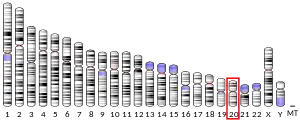| SEMG1 | |||||||||||||||||||||||||||||||||||||||||||||||||||
|---|---|---|---|---|---|---|---|---|---|---|---|---|---|---|---|---|---|---|---|---|---|---|---|---|---|---|---|---|---|---|---|---|---|---|---|---|---|---|---|---|---|---|---|---|---|---|---|---|---|---|---|
| Identifiers | |||||||||||||||||||||||||||||||||||||||||||||||||||
| Aliases | SEMG1, CT103, SEMG, SGI, dJ172H20.2, Semenogelin I, semenogelin 1 | ||||||||||||||||||||||||||||||||||||||||||||||||||
| External IDs | OMIM: 182140 HomoloGene: 130511 GeneCards: SEMG1 | ||||||||||||||||||||||||||||||||||||||||||||||||||
| |||||||||||||||||||||||||||||||||||||||||||||||||||
| |||||||||||||||||||||||||||||||||||||||||||||||||||
| |||||||||||||||||||||||||||||||||||||||||||||||||||
| |||||||||||||||||||||||||||||||||||||||||||||||||||
| Wikidata | |||||||||||||||||||||||||||||||||||||||||||||||||||
| |||||||||||||||||||||||||||||||||||||||||||||||||||
Semenogelin-1 is a protein that in humans is encoded by the SEMG1 gene.[3][4][5] The protein encoded by this gene is the predominant protein in semen. The encoded secreted protein is involved in the formation of a gel matrix that encases ejaculated spermatozoa. The prostate-specific antigen (PSA) protease processes this protein into smaller peptides, with each possibly having a separate function. The proteolysis process breaks down the gel matrix and allows the spermatozoa to move more freely. Two transcript variants encoding different isoforms have been found for this gene.[5]
See also
References
- 1 2 3 GRCh38: Ensembl release 89: ENSG00000124233 - Ensembl, May 2017
- ↑ "Human PubMed Reference:". National Center for Biotechnology Information, U.S. National Library of Medicine.
- ↑ Lilja H, Abrahamsson PA, Lundwall A (Mar 1989). "Semenogelin, the predominant protein in human semen. Primary structure and identification of closely related proteins in the male accessory sex glands and on the spermatozoa". J Biol Chem. 264 (3): 1894–900. doi:10.1016/S0021-9258(18)94272-9. PMID 2912989.
- ↑ Jonsson M, Linse S, Frohm B, Lundwall A, Malm J (Apr 2005). "Semenogelins I and II bind zinc and regulate the activity of prostate-specific antigen". Biochem J. 387 (Pt 2): 447–53. doi:10.1042/BJ20041424. PMC 1134973. PMID 15563730.
- 1 2 "Entrez Gene: SEMG1 semenogelin I".
Further reading
- Robert M, Gagnon C (1999). "Semenogelin I: a coagulum forming, multifunctional seminal vesicle protein". Cell. Mol. Life Sci. 55 (6–7): 944–60. doi:10.1007/s000180050346. PMID 10412373. S2CID 31516685.
- Ulvsbäck M, Lazure C, Lilja H, et al. (1992). "Gene structure of semenogelin I and II. The predominant proteins in human semen are encoded by two homologous genes on chromosome 20". J. Biol. Chem. 267 (25): 18080–4. doi:10.1016/S0021-9258(19)37155-8. PMID 1517240.
- Schneider K, Kausler W, Tripier D, et al. (1989). "[Isolation and structure determination of two peptides occurring in human seminal plasma]". Biol. Chem. Hoppe-Seyler. 370 (4): 353–6. doi:10.1515/bchm3.1989.370.1.353. PMID 2757795.
- Li CH, Hammonds RG, Ramasharma K, Chung D (1985). "Human seminal alpha inhibins: isolation, characterization, and structure". Proc. Natl. Acad. Sci. U.S.A. 82 (12): 4041–4. Bibcode:1985PNAS...82.4041L. doi:10.1073/pnas.82.12.4041. PMC 397930. PMID 3889920.
- Lilja H, Jeppsson JO (1985). "Amino acid sequence of the predominant basic protein in human seminal plasma". FEBS Lett. 182 (1): 181–4. doi:10.1016/0014-5793(85)81179-0. PMID 3972122. S2CID 31277428.
- Ramasharma K, Sairam MR, Seidah NG, et al. (1984). "Isolation, structure, and synthesis of a human seminal plasma peptide with inhibin-like activity". Science. 223 (4641): 1199–202. Bibcode:1984Sci...223.1199R. doi:10.1126/science.6422553. PMID 6422553.
- Lilja H, Laurell CB, Jeppsson JO (1984). "Characterization of the predominant basic protein in human seminal plasma, one cleavage product of the major seminal vesicle protein". Scand. J. Clin. Lab. Invest. 44 (5): 439–46. doi:10.3109/00365518409083835. PMID 6484484.
- Seidah NG, Ramasharma K, Sairam MR, Chrétien M (1984). "Partial amino acid sequence of a human seminal plasma peptide with inhibin-like activity". FEBS Lett. 167 (1): 98–102. doi:10.1016/0014-5793(84)80840-6. PMID 6698208. S2CID 27647296.
- Khan Z, Smyth DG (1993). "Isolation and identification of N-terminally extended forms of 5-oxoprolylglutamylprolinamide (Glp-Glu-Pro-NH2), a thyrotropin-releasing-hormone (TRH)-like peptide present in human semen". Eur. J. Biochem. 212 (1): 35–40. doi:10.1111/j.1432-1033.1993.tb17629.x. PMID 8444163.
- Lundwall A (1996). "The structure of the semenogelin gene locus--nucleotide sequence of the intergenic and the flanking DNA". Eur. J. Biochem. 235 (3): 466–70. doi:10.1111/j.1432-1033.1996.00466.x. PMID 8654389.
- Malm J, Hellman J, Magnusson H, et al. (1996). "Isolation and characterization of the major gel proteins in human semen, semenogelin I and semenogelin II". Eur. J. Biochem. 238 (1): 48–53. doi:10.1111/j.1432-1033.1996.0048q.x. PMID 8665951.
- Bjartell A, Malm J, Moller C, et al. (1997). "Distribution and tissue expression of semenogelin I and II in man as demonstrated by in situ hybridization and immunocytochemistry". J. Androl. 17 (1): 17–26. doi:10.1002/j.1939-4640.1996.tb00582.x. PMID 8833737. S2CID 20337870.
- Robert M, Gibbs BF, Jacobson E, Gagnon C (1997). "Characterization of prostate-specific antigen proteolytic activity on its major physiological substrate, the sperm motility inhibitor precursor/semenogelin I.". Biochemistry. 36 (13): 3811–9. doi:10.1021/bi9626158. PMID 9092810.
- Peter A, Lilja H, Lundwall A, Malm J (1998). "Semenogelin I and semenogelin II, the major gel-forming proteins in human semen, are substrates for transglutaminase". Eur. J. Biochem. 252 (2): 216–21. doi:10.1046/j.1432-1327.1998.2520216.x. PMID 9523691.
- Lövgren J, Airas K, Lilja H (1999). "Enzymatic action of human glandular kallikrein 2 (hK2). Substrate specificity and regulation by Zn2+ and extracellular protease inhibitors". Eur. J. Biochem. 262 (3): 781–9. doi:10.1046/j.1432-1327.1999.00433.x. PMID 10411640.
- Malm J, Hellman J, Hogg P, Lilja H (2000). "Enzymatic action of prostate-specific antigen (PSA or hK3): substrate specificity and regulation by Zn(2+), a tight-binding inhibitor". Prostate. 45 (2): 132–9. doi:10.1002/1097-0045(20001001)45:2<132::AID-PROS7>3.0.CO;2-3. PMID 11027412. S2CID 35309283.
- Deloukas P, Matthews LH, Ashurst J, et al. (2002). "The DNA sequence and comparative analysis of human chromosome 20". Nature. 414 (6866): 865–71. Bibcode:2001Natur.414..865D. doi:10.1038/414865a. PMID 11780052.
- Brillard-Bourdet M, Réhault S, Juliano L, et al. (2002). "Amidolytic activity of prostatic acid phosphatase on human semenogelins and semenogelin-derived synthetic substrates". Eur. J. Biochem. 269 (1): 390–5. doi:10.1046/j.0014-2956.2001.02667.x. PMID 11784334.
This article is issued from Wikipedia. The text is licensed under Creative Commons - Attribution - Sharealike. Additional terms may apply for the media files.


